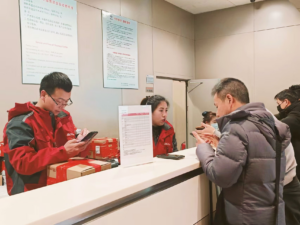May 15, 2020|
In-Depth Report: JD Cold Chain Logistics: Building Strength on Strength for Customers
by Ling Cao
JD’s cold chain logistics has been key in both ensuring livelihood during the epidemic as well as transporting medical supplies that have specific temperature requirements.
JD internal data shows that JD cold chain orders in Q1 2020 increased 200% y-o-y. In early April, with resumption of transportation in and around Hubei province, JD’s Asia No.1 logistics park in Wuhan is seeing robust growth in number of orders, with almost 1,400 tons of fresh food products from Hubei sold on JD.com within one week. Among these, oranges, crawfish and lotus roots were the best-sellers.
From food to medical supplies
JD cold chain was also key to medical supply delivery, especially when there were insufficient transportation resources during the virus outbreak. During these challenging times, JD consistently transported COVID-19 nucleic acid testing kits, insulin and other medical supplies from medical institutions to cities in China, and the integrated fulfillment process was cold chain guaranteed.
Unlike typical delivery, cold chain logistics has a higher standard. As one of JD’s six major logistics networks (with the other five being normal-sized items, bulky items, B2B, cross-border, and crowd-sourced), JD established its cold chain logistics network in 2014, which was in response to the increasing demand for JD’s fresh food orders.
Customers tend to buy high quality products on JD, which gives rise to the needs for this type of delivery service. While delivery is only a small part of the entire cold chain logistics infrastructure (since the product is produced from a farm or made in a factory) the whole supply chain need be protected by the cold chain. That’s also why in 2018, in addition to the B2C (business to customer) cold chain delivery, JD cold chain has started to build the B2B (business to business) network.
Now JD has already built China’s leading F2B2C (farm/factory to business, or business to customers, or farm/factory to customers directly) cold chain network for all kinds of models itself and by integrating industry resources. Taking the food industry for example, cold chain is the infrastructure employed for food product circulation.
For instance, cherries are harvested in April, and they are delicious while easy to rot. Conditions cannot be too dry or too damp, and they require a specific rigorous fulfillment process. JD has built over 10 sorting centers around the country near places of origin, including Yantai, Weifang in Shandong province and Dalian in Liaoning province, so that JD can transport the cherries from farms to customers directly. JD’s cold chain logistics is able to provide cherry delivery to 300 cities across China in as fast as within 24 hours.
The case of ice cream
Ice cream is another example. It is popular especially during summer time, but when customers buy a cup of ice cream at the supermarket, they sometimes discover ice slag on the cover, which negatively impacts the taste. This occurs because the product has lost temperature control for at least 15 minutes during the course of transportation. This results in external air moisture entering to form condensed water. JD cold chain logistics can help deal with this challenge.
Mengniu, China’s leading manufacturing and distribution company of dairy products and ice cream, is one of JD’s important partners for cold chain logistics since June 18th, 2019, when JD had a Grand Promotion Day. According to the partnership, JD provides Mengniu’s frozen food products with integrated cold chain warehousing, transportation and delivery service, creating integrated cold chain solutions from Mengniu’s factory to the customers’ table.
Logistics quality is a perennial challenge for ice cream sales – especially for ice cream that has richer dairy content, which will melt immediately when the temperature rises. To address the challenge, besides JD’s existing integrated cold chain network, JD also leverages technology to meet demand. For example, JD will stock the ice cream in different sectors of the warehouse, normally -18℃ and -35℃, and leverage the self-developed smart temperature control platform which can ensure that the whole supply chain is transparent and traceable. It can also provide tailored solutions corresponding to different temperature requirements.
JD also leverages a goods-to-person sorting system in its cold chain warehouse, which will improve efficiency for the sorting process, shortening the length of time for the product to arrive to customers. Using JD’s Beijing cold chain sorting center as an example, the automatic sorting facility has increased 300% sorting efficiency, as well as shortening the fulfillment process.
By being technology-driven and based on a mature cold chain infrastructure, JD has helped Mengniu manage its inventory for all online sales channels, which is essential to protecting the products’ consistent temperature requirement for the whole process.
A spokesperson from Mengniu said, “Our cooperation with JD is a creative initiative that will strengthen our cold chain logistics capability, as well as enable expansion to lower tier markets, providing more customers with fresher frozen food products.”
JD and Mengniu’s cooperation continues. During the epidemic, JD received a request from Mengniu to help them with B2C delivery services in response to new business demands, helping them launch the new business in just four days.
“Our new business launched on February 15th during the peak period of the virus, when there was a lack of trucks and personnel in the market. Despite the challenges, JD helped us launch the business as we expected,” the Mengniu spokesperson added.
A ¥400B yuan market
The CCLC (Cold Chain Logistics Committee) from CFLP (China Federation of Logistics & Purchasing) forecasts that the market share of China’s cold chain logistics will hit RMB 400 billion yuan in 2020. Yet, cold chain service providers haven’t reached a large scale, and 90% of them are regional enterprises which only provide some services for specific products.
Compared with some developed countries which have mature cold chain logistics, the cold chain logistics industry in China is still developing. The main industry pain points include low shipping standards and multiple small logistics suppliers. JD has tried to address these by building an innovative network design that combines a self-developed network with partner cooperation. Specifically, JD will build key and core nationwide warehousing and transportation network. Regarding regional resources, JD will select qualified local partners, which will shift the nature of previous competition to shared value. At the same time, JD will also open its supply chain management solutions to help local partners upgrade their efficiency overall.
Xiuqiang Li, head of strategy and planning for JD cold chain logistics said, “JD’s advantage is integrating social resources together, which will benefit all stakeholders, eventually improving the overall customer experience.”
Four temperature layers
JD has already explored a unique way to develop its own cold chain logistics. Regarding how to make the business sustainable and profitable, Li said, “It’s a matter of being cost-effective and at scale. We believe JD’s business model for cold chain is a win-win initiative for the industry, partners and customers, and we will continue to develop our network and deepen our cooperation with partners throughout the supply chain.”
So far, JD has operated over 20 cold chain warehouses for fresh food, covering four temperature layers: cryogenic, freezing, refrigerated and temperature-controlled. Temperature ranges from -30 ℃ to normal temperature to satisfy tailored storage needs. For the B2B business, JD’s integrated cold chain logistics network within one city can cover 23 cities, and will expand to 34 cities this year, the less-than-truck-load network can cover over 240 cities, will expand to 350 cities this year, and develop further.
JD can also personalize the containers, offering dry ice and other refrigerants for different products. In 2019, JD used green recycling boxes and cold chain containers a total of 47 million times, making the business more sustainable.
In sum, cold chain logistics is a key way that JD will continue to build trust with partners and consumers – building strength on strength with its supply chain.










 This Harbin tourism boom has also spurred a surge in sales of winter apparel. JD.com’s data indicates a rapid growth in the sales of warm clothing items such as down jackets, snow boots, and thermal underwear between January 1st and 7th. The sales growth is especially pronounced in southern provinces and cities such as Jiangsu, Zhejiang, Guangdong, Sichuan, and Shanghai. Notably, tall snow boots registered a 206% year-on-year increase in transactions, while padded cotton caps and thickened long down jackets soared by 158% and 134%, respectively. Beyond clothing, travel gear has also seen a considerable uptick, with a 98% year-on-year growth in transactions for large suitcases and travel backpacks in these southern regions.
This Harbin tourism boom has also spurred a surge in sales of winter apparel. JD.com’s data indicates a rapid growth in the sales of warm clothing items such as down jackets, snow boots, and thermal underwear between January 1st and 7th. The sales growth is especially pronounced in southern provinces and cities such as Jiangsu, Zhejiang, Guangdong, Sichuan, and Shanghai. Notably, tall snow boots registered a 206% year-on-year increase in transactions, while padded cotton caps and thickened long down jackets soared by 158% and 134%, respectively. Beyond clothing, travel gear has also seen a considerable uptick, with a 98% year-on-year growth in transactions for large suitcases and travel backpacks in these southern regions. Norwegian Cod and Salmon Sold on JD Seafood Festival
Norwegian Cod and Salmon Sold on JD Seafood Festival



